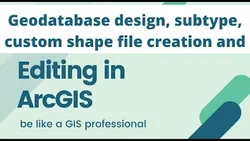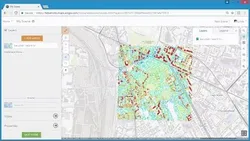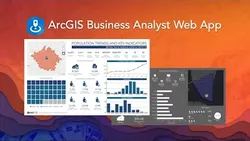
Deep Learning 
ArcGIS Pro can be used to classify features with multiple labels, extract residential parcels from imagery using BDCN and HED, use the Pix2Pix model in arcgis.learn, and extract roads from satellite imagery. arcgis.learn provides powerful tools to help users quickly and accurately complete these tasks. ▼
ADVERTISEMENT
Course Feature
![]() Cost:
Cost:
Free
![]() Provider:
Provider:
Youtube
![]() Certificate:
Certificate:
Paid Certification
![]() Language:
Language:
English
![]() Start Date:
Start Date:
On-Demand
Course Overview
❗The content presented here is sourced directly from Youtube platform. For comprehensive course details, including enrollment information, simply click on the 'Go to class' link on our website.
Updated in [February 21st, 2023]
How To: Classify a Feature with Multiple Labels Using ArcGIS Pro.
How To: Extract Residential Parcels from Imagery Using arcgis.learn (BDCN and HED).
How To: Use the Pix2Pix Model in arcgis.learn.
How To: Extract Roads from Satellite Imagery Using arcgis.learn.
How To: Digitize and Georeference from Scanned Paper Maps Using arcgis.learn.
How To: Classify Point Cloud Datasets Using arcgis.learn.
(Please note that we obtained the following content based on information that users may want to know, such as skills, applicable scenarios, future development, etc., combined with AI tools, and have been manually reviewed)
1. Understanding ArcGIS Pro: This online course provides learners with an introduction to ArcGIS Pro, a powerful GIS software used to create, analyze, and manage geographic data. Learners will gain an understanding of the features and capabilities of ArcGIS Pro, as well as how to use it to classify features with multiple labels, extract residential parcels from imagery, use the Pix2Pix model, extract roads from satellite imagery, digitize and georeference from scanned paper maps, and classify point cloud datasets.
2. Working with Imagery: Learners will gain an understanding of how to work with imagery in ArcGIS Pro, including how to extract residential parcels from imagery, extract roads from satellite imagery, and digitize and georeference from scanned paper maps. They will also learn how to use the Pix2Pix model to generate realistic images from a given input.
3. Classifying Features: Learners will learn how to classify features with multiple labels in ArcGIS Pro, as well as how to classify point cloud datasets. They will gain an understanding of the different methods used to classify features, and how to apply them to their own data.
4. Working with Maps: Learners will gain an understanding of how to work with maps in ArcGIS Pro, including how to digitize and georeference from scanned paper maps. They will learn how to create and edit maps, as well as how to use the various tools available in ArcGIS Pro to manipulate and analyze their data.
5. Analyzing Data: Learners will gain an understanding of how to analyze data in ArcGIS Pro, including how to use the various tools available to manipulate and analyze their data. They will learn how to use the Pix2Pix model to generate realistic images from a given input, as well as how to classify point cloud datasets.
[Applications]
The application of this Deep Learning course can be seen in a variety of ways. For example, users can use the techniques learned to classify features with multiple labels using ArcGIS Pro, extract residential parcels from imagery using arcgis.learn (BDCN and HED), use the Pix2Pix model in arcgis.learn, extract roads from satellite imagery using arcgis.learn, digitize and georeference from scanned paper maps using arcgis.learn, and classify point cloud datasets using arcgis.learn. Additionally, users can apply the knowledge gained from this course to other areas of deep learning, such as image recognition, natural language processing, and machine learning.
[Career Paths]
1. GIS Analyst: GIS Analysts use geographic information systems (GIS) to analyze and interpret data related to the Earth's surface. They use GIS software to create maps, analyze spatial data, and develop models to solve problems. GIS Analysts are in high demand as the use of GIS technology continues to grow and develop.
2. Remote Sensing Analyst: Remote Sensing Analysts use satellite imagery and other remote sensing technologies to analyze and interpret data related to the Earth's surface. They use GIS software to create maps, analyze spatial data, and develop models to solve problems. With the increasing use of satellite imagery and other remote sensing technologies, the demand for Remote Sensing Analysts is expected to grow.
3. Machine Learning Engineer: Machine Learning Engineers use deep learning algorithms to analyze and interpret data. They use GIS software to create maps, analyze spatial data, and develop models to solve problems. With the increasing use of machine learning and artificial intelligence, the demand for Machine Learning Engineers is expected to grow.
4. Data Scientist: Data Scientists use data analysis techniques to analyze and interpret data. They use GIS software to create maps, analyze spatial data, and develop models to solve problems. With the increasing use of data science and analytics, the demand for Data Scientists is expected to grow.
Course Provider

Provider Youtube's Stats at AZClass
Discussion and Reviews
0.0 (Based on 0 reviews)
Explore Similar Online Courses

C# 10 Fundamentals

Digital Character Design: Draw Protagonists with Personality

Python for Informatics: Exploring Information

Social Network Analysis

Introduction to Systematic Review and Meta-Analysis

The Analytics Edge

DCO042 - Python For Informatics

Causal Diagrams: Draw Your Assumptions Before Your Conclusions

Whole genome sequencing of bacterial genomes - tools and applications

How to create new shape file and geodatabase in ArcGIS

3D GIS


Start your review of Deep Learning